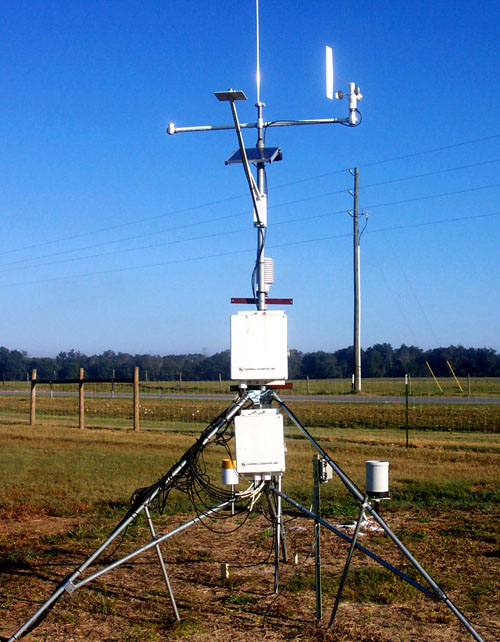The Georgia Automated Environmental Monitoring Network, operated by the University of Georgia College of Agricultural and Environmental Sciences, is in jeopardy due to key faculty and funding losses. Georgia farmers depend on the network for weather, soil and water information that helps them make the quick decisions needed to efficiently produce their crops.
“Originally, it looked as though we would have to start decommissioning the 81-station network in mid-April,” said J. Scott Angle, CAES dean and director. “We have since secured some funds to give us a bit wider window to find the full funds needed to keep the network afloat.”
The network cost more than $300,000 annually to operate.
Each station in the AEMN records rainfall, air and soil temperature, relative humidity, wind speed and direction, solar radiation, soil moisture and barometric pressure. Some stations record evaporation, water temperature and leaf wetness. All these values are read every second and averaged and recorded every 15 minutes on site.
The information doesn’t just help farmers. It helps a wide range of groups, including utility companies, which are the network’s heaviest users. The companies use the system to determine peak-usage times, which helps them make valuable production and billing decisions.
“The utility companies are the largest users of the network, but also reap the biggest benefits,” Angle said.
Other users include food brokers from around the world who need information about how Georgia crops are doing in order to make purchasing decisions. The system is used by event planners, golf course superintendents, schoolteachers and students, too.
For almost 20 years, anyone could use the system for free. The network website averages more than a half a million hits by over 60,000 separate visitors per month. Almost 300,000 of the hits come from within Georgia.
“Closing the system would cause serious problems for so many in the state,” Angle said. “We are doing all we can to avoid that. But, it is obvious that we will no longer be able to afford to offer this service for free.”
Angle said the college is looking at several models for making the system a sustainable service at a reasonable cost to users who need the information. In a recent discussion with Georgia commodity groups, farmers from across the state pledged support for a subscriber-based system.
“That was good to hear,” Angle said. “As growers already face high input costs this year from the rising prices of fuel and fertilizer, you hate to ask them to dip deeper into their profits to fund a service you have been providing for free. I was glad to hear they value this tool enough to want to chip in to help us keep it alive.”
Subscriptions will certainly help, Angle said, but to make the system sustainable long-term will require major contributions from organizations whose members rely on the system and have a vested interest in keeping it viable.
For regular updates about the status of the AEMN, or to learn more about it, go to the system’s website at http://www.georgiaweather.net








